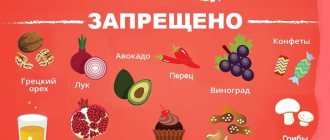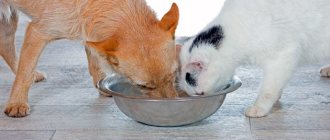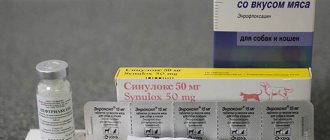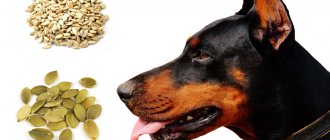Dogs' diet should be balanced. For good health, she must receive a sufficient amount of animal protein, the main sources of which are meat and fish. Meat is the main product of a dog's diet. But what about fish? A good owner knows that you shouldn’t forget about it, because such a unique composition of nutrients is not found in any other product. In order for the consumption of this food to bring maximum benefit to the animal, all subtleties and nuances in its selection and preparation should be taken into account. From this article you will find out whether you can feed your dog fish, what kind and in what form (boil it or leave it raw).
What kind of fish can dogs be given?
The digestive system of tetrapods is different from that of humans. Animals can accumulate hair in their stomachs, rough food is easily digested, and sometimes even bones come out without difficulty.
However, this does not mean that you can feed your furry friend anything. Allowed types of fish for dogs:
- all salmon (coho salmon, char, brown trout, Chinook salmon, chum salmon, pink salmon, sockeye salmon, salmon, whitefish);
- river trout;
catfish;- herring;
- sardine;
- anchovies;
- grayling;
- hake;
- haddock;
- whiting;
- flounder.
What types of fish can you feed your dog?
The healthiest fish to feed dogs is the one caught in the ocean or sea. Professional breeders recommend paying attention to the following varieties of fish:
- sea bass;
- ice fish;
- herring;
- flounder;
- capelin;
- hake;
- mackerel.
River fish is also not prohibited for use in feeding a dog.
It is recommended to turn your attention to trout, silver carp, pike perch, salmon and eel. Fatty varieties of fish are beneficial for the young growing organisms of puppies. The benefits of eating fish are noted for bitches during the period of bearing puppies, the lactation period, as well as for dogs living on the street.
If there is a malfunction of the pancreas or problems with the hepatobiliary system, it is not recommended to use fish. Fish meat is prohibited for dogs with low physical activity and excess weight.
Restrictions
Not all fish are suitable for dogs.
The following species should not be given raw:
- sardinops;
- Chukuchan;
- bream;
- pike;
- carp;
- anchovy;
eel-pout;- sprat;
- smelt;
- ide;
- herring;
- capelin;
- sardine;
- sprat
This is not a complete list. Quadrupeds should not be given varieties that contain thiaminase in their tissues. This component destroys vitamin B.
The enzyme is found in the internal organs and head. Thiaminase is deactivated at high temperatures.
You can add fish to your animal’s diet by boiling it first. Just don't get carried away.
Some varieties contain trimethylamine oxide. This organic substance negatively affects the absorption of iron into the blood, causing anemia. Feeding animals with some varieties leads to infertility, anemia and other ailments.
To prevent iron deficiency anemia, it is recommended to give boiled fish or add iron-containing foods to food. The first option is preferable so as not to cause an excess of iron in the body. Pets are allowed:
hake;- pollock;
- silver hake;
- pollock;
- whiting;
- pout.
Four-legged animals should not be given milk: the product is fatty and causes gastrointestinal upset.
It is not advisable to feed your pets fish pulp from the scombroid family because of the histamine it contains. If the product is stored incorrectly, dogs are at risk of food poisoning.
Poisonous fish species are prohibited. These species are rare, but you should be aware of them. This:
- temple;
- barbel;
- dog fish;
- Ottomans;
- Balkhash Marinka
Which one should not be given to dogs?
Before giving your dog fish, you need to know that not all varieties are approved for feeding your pet.
River
Chicken feet for dogs, as well as heads: is it possible to give
Feeding your pet with carp, bream, and pike is prohibited. These varieties contain the substance thiaminase, which destroys vitamin B in the animal’s body.
Marine
Hake, mackerel, pollock and capelin are strictly forbidden to be given to dogs. The reason is the content of the substance trimethylamine oxide in these varieties. It binds iron, preventing its absorption by the animal’s body, which causes the development of iron deficiency anemia. Is it possible to give whiting to a dog - no, this product is also prohibited.
Attention! Marine species can cause infertility in dogs.
Is it allowed to give to puppies?
Puppies, like adults, can and should be given fish products. This should be done with caution.
Important details:
The fish is given without bones and heads.- Before serving, the product should be passed through a meat grinder; grinding in a blender is allowed.
- Any fish must undergo heat treatment. The product is simmered over low heat for at least 15 minutes after boiling.
- For puppies, fish is mixed with porridge.
At what age can you give
Fish should appear in a dog's diet from 2.5-3 months . Puppies should be gradually fed the delicacy, making sure that they do not develop allergies.
How many grams of fish can you give a dog per day?
To feed your pet correctly, you need to know how much of the product is allowed. The dose depends on the weight of the animal. The volume of the product is calculated based on the formula - 3% fish by weight of the animal. For example, a Jack shepherd weighing 30 kg can eat no more than 600 g.
How to teach a dog to fish
You need to accustom your pet gradually, starting with small pieces, carefully crushed and mixed with other products. After the first time, it is necessary to monitor the animal’s reaction, since a fish dish can cause short-term, minor diarrhea.
The fish must be pre-processed - boiled or frozen; it cannot be given immediately after catching.
How to feed fish correctly
Feeding raw fish is not recommended. Firstly, such a product can be dangerous to the health and life of the pet, and secondly, it contains helminths.
It is optimal to use frozen fillets or cooked fish. The bones need to be removed. This is especially true for feeding small dogs. They need to grind the pieces before feeding.
It is sometimes allowed to cook fish broth, it is important to ensure that it is low-fat. You can make soup by adding cereals and vegetables to it.
How to properly cook fish for a dog
Canines prefer fish meat mixed with other ingredients (cereals, vegetables). Simple dishes help diversify their table.
Introduction to diet
Accustoming to a new table begins with the addition of small crushed pieces mixed with familiar foods. After the first feeding, you need to monitor the dog’s reaction: if eating disorders appear, the fish is canceled.
For small breeds, it is ground in a blender and alternated with vein meat. Heat treatment or freezing will prevent the Jack Russell Terrier and Yorkie from becoming infected with helminths and will reduce the risk of deficiency of certain vitamins. Owners should be aware that fatty varieties (containing above 15% fat) can cause indigestion and vomiting.
Important! If the pet refuses what is offered and prefers only meat, then the lack of useful ingredients is compensated for with multivitamin complexes.
In what form and what kind of fish can be given and what not?
The product is not always given to animals in boiled form, which is not always healthy.
Choose:
- raw;
- salty;
smoked;- dried;
- fried.
It is allowed to give a dog a product that has lain at -22 °C for a day or has been at a temperature of -18 °C for two weeks. It is dangerous to give other types.
Salty
It is better to avoid salted fish: salt disrupts the water-salt balance, leading to serious illnesses.
It is allowed to feed your pet a small piece of lightly salted herring, but not more than twice a month. Stray dogs eat pickles, which help restore sodium salts in the body.
Smoked
Modern smoking is far from ideal. To save money, they use cheap chemical additives in which the product is soaked and then lightly smoked.
This kind of smoked fish should not be given - it harms the pancreas, liver, gastrointestinal tract, and causes allergies.
Dried
Dried fish is also prohibited. The product contains excessive amounts of salt, which is harmful to the animal.
As an exception, a small piece is allowed several times a year.
Fried
Fried food should not be given to animals. Fish is no exception. Overheated fat absorbed by the product leads to a number of diseases.
How to give?
Fish should be given to dogs as a separate feeding. Larger animals can be offered the herring whole, while smaller ones can be cut into pieces.
In terms of quantity, give 30 percent of the diet. It is recommended to offer herring only once a week. It is not necessary to boil it; it is enough to freeze it to get rid of dangerous parasites.
Before feeding, the fish should be kept at room temperature for a while to thaw. You can prepare soup with vegetables in fish broth, which dogs really like.
Fish soup or broth
Ferments are harmful to dogs, they make the animal sick, the stool is disrupted, the quality of the coat and the well-being of the shaggy friend deteriorate. It is better to avoid broths.
The exceptions are sick animals, nursing bitches, and puppies. The liquid should be non-greasy. Fish soup is allowed, but the share of the main product cannot exceed 15% of the total weight.
Food for an animal should not contain bones or entrails, only fish meat.
By-products
Heads
Fish heads should not be added to food for small dogs - the animal may choke. Sometimes these by-products are acceptable for shepherds, St. Bernards and other large breeds.
Raw pink salmon heads are especially useful, but regularly eating such food is fraught with problems with the gastrointestinal tract.
Fish bones
Boiled bones are allowed for consumption, but in small quantities.
Sharp bones must be removed from the fish before feeding. Fish fillets with bones clog the stomach and intestines. Babies sometimes develop obstruction, leading to death.
Kinds
River fish
Animals rarely eat lake and river fish on their own. Red varieties are best. River trout is ideal. Before serving, it must be frozen or boiled so as not to infect the dog with worms.
Should I feed the sea
Such fish does not need to be frozen, because the presence of helminths in it is rare. The product is rich in vitamins, iodine, phosphorus, and fats.
Quadrupeds willingly consume sea creatures, which are tastier, more aromatic, and richer than river rocks.
What beneficial substances do dogs need in fish?
Fish is a storehouse of useful minerals, trace elements, and vitamins. Animals need the product no less than people.
Fish has high nutritional value; it contains a lot of protein, unsaturated fatty acids, and amino acids.
The most important microelements:
- copper;
- lithium;
- zinc;
iron;- cobalt;
- iodine;
- phosphorus.
Fish contains a large amount of vitamins and essential natural chondroprotectors that protect joints and bones and prevent their early destruction.
Antioxidants are indispensable for animals, especially in old age. The components are found in salmon and cod.
Fish fat
This product can and should be given. It contains Omega 3, Omega 6. These components protect the heart and blood vessels from the negative influence of the environment, help normalize blood pressure, and prevent inflammatory processes.
Fat contains vitamins A, D, E. It is indispensable for young dogs, whose growing body requires a full range of microelements.
For puppies from 1.5-2 months, it is enough to mix 1 tsp into their food daily. fat, starting the first week with 3-5 drops. For adult animals, the supplement is recommended in courses. The method of use and dosage will be advised by your veterinarian.
Types of fish and their properties
Based on their habitat, it is customary to distinguish all species of fish into several groups:
- oceanic and marine - living in salt water;
- freshwater - living and spawning in rivers or lakes;
- migratory - lives in the sea, but goes to rivers to spawn. And there is one that, on the contrary, lives in the river and goes to salty sea waters to spawn.
Sea and river fish have many differences. The first concerns size - species living in seawater are much larger than freshwater ones. The second is structure: in sea inhabitants the skeleton consists of a much smaller number of bones compared to river and lake inhabitants. This feature is determined by the habitat. River fish have to constantly overcome the current and slight water pressure, so they have a powerful backbone, reinforced by a large number of bones. Sea and ocean fish are less bony.
What are the benefits of sea fish?
Sea fish is divided into two types - skinny and medium fat, with white meat (hake, haddock, cod, pollock) and fatty (herring, salmon, mackerel and others). The former contain a lot of proteins and minerals, but are low in fat. The second has a higher percentage of fat content. Fish oils are easily digestible and contain little cholesterol. The important components are:
- taurine This amino acid plays an important role in many processes occurring in the pet’s body. In dogs, it is synthesized independently, but sometimes animals can suffer from taurine deficiency. This leads to impaired myocardial function;
- tryptophan. This amino acid affects the activity of the central nervous system, increases the dog’s body’s ability to resist stress and negative environmental factors;
- lysine. In the body of pets, this amino acid strengthens the health of the respiratory system and supports the immune system;
- vitamins of group B, as well as A, D, E, PP;
- macro- and microelements, the most important of which are calcium, magnesium and phosphorus. In addition, sea fish is rich in iodine, copper, manganese, zinc - minerals that improve metabolic processes in the dog's body, iron, which normalizes the blood formula, fluorine, bromine and boron - minerals that support the health of the thyroid gland.
But the most valuable property of sea and ocean fish is the presence of polyunsaturated fatty acids Omega-3 and Omega-6. Their consumption with food reduces the risk of developing cardiovascular diseases and cancer, normalizes the functions of the central and peripheral nervous system, and has a positive effect on the life expectancy of pets. Sea bass, pollock, cod, salmon, and herring are rich in Omega-3 and Omega-6 acids, but the latter are not recommended for pets because they have a high fat content.
Deficiency of polyunsaturated fatty acids in the body of dogs is manifested by slow growth and development (in puppies), damage to the skin, disruption of the water-salt balance in the body, increased susceptibility to infectious diseases, and degenerative changes in some internal organs.
Sea fish poses a risk of helminthiasis infection to a lesser extent than river and lake fish. This is largely explained by the fact that it arrives on store shelves frozen, as a result of which the helminths die. However, it is not recommended to give raw fish to pets.
Marine life contains less heavy metals, pesticides, radionuclides and other substances that negatively affect animal health. They live in cleaner environmental conditions, and the rivers and lakes in which freshwater fish are caught are often polluted as a result of the economic activities of industrial enterprises.
Features of freshwater fish
Fish that live in freshwater bodies of water - rivers, ponds, lakes - contain a lot of valuable protein and amino acids - primarily methionine. This substance controls the functioning of the central nervous system, inhibits the process of leaching calcium from the body, and activates enzymes. Methionine is a sulfur-containing amino acid that is involved in biochemical reactions occurring in the body of dogs and reduces the level of bad cholesterol.
River fish contains a lot of minerals, and the iron it contains is absorbed much better than that which enters the pet’s body with sea fish. But freshwater inhabitants contain much less polyunsaturated fatty acids; in addition, they are often infected with dangerous helminths, which can cause the development of serious diseases affecting internal organs. Therefore, before giving your dog fish, it should be thoroughly boiled in boiling water.
Dry food based on seafood
Some breeders feed their dogs not regular food, but dry food that contains seafood.
This option is acceptable, but provided that the products are purchased in a super premium class. This “drying” contains all the necessary elements, microelements, vitamins and additives. The food is balanced and suitable for all four-legged animals. You can choose food based on your pet’s age, breed and taste preferences.
“Drying” should be given as constant nutrition. It is impossible to replace the vitamins contained in fish products with food. You should feed the animal either prepared food or regular food, including in the diet everything that the pet needs.
When is it better to refrain from feeding fish?
You need to select products carefully, following all the rules. Animals should not be given backbones, gills, entrails or bones.
When boiling fish, you need to first clean it, removing everything unnecessary. This food should not be offered to dogs that are allergic to one or another variety.
This usually applies to red fish species. You should start adding a new component to food carefully and gradually to see how the body reacts.
What are the dangers of using
If the rules are not followed, the animal may develop allergies, gastrointestinal problems, and even die.
You should not give dogs cleaned seafood (mussels, rapana, shrimp and others) from the table or seafood in its pure form. Sharp edges injure not only the mucous membrane in the oral cavity, but also the intestinal walls.











